语言学期末(这份是正确的)
文化语言学期末试题

文化语言学期末考试试题一、单项选择题(每题两分,共10题)1.三大古典文字是()A.甲骨文、玛雅文字、彝文B.甲骨文、圣书字、楔形文字C.玛雅文字、谚文、彝文D.楔形文字、谚文、玛雅文字2. 下面哪种文字不属于汉字体系表意文字()A.壮字B.朝鲜谚文字母C.女真字D.西夏字3. 彝族人叫妻子做“穿针婆”(直译“针穿母”)这反映了语言可以反映()A.物质文化B.精神文化C.行为文化D.制度文化4. 下列关于“楔形文字”的叙述不正确的一项是( )A.楔形文字的得名是因为在泥版上压印出的字的笔道像一个个“楔子”B.楔形文字不如刻画出的文字象形C.楔形文字的初始字符大多是象形字D.阿卡德人并没有继承“楔形文字”5.下面哪个借词是清朝出现的借词()A.胡同B.把式C.站D.支那6.湖南省江永县妇女中间流传一种文字,妇女创造,妇女使用,被称为“女书”。
下列那种说法不符合女书的特点?A.笔迹秀丽娟细B.外形斜方,似蚊型C.全是独体字D.是一种音节文字7. 下列关于文化语言学的描述哪个是正确的()A.文化语言学是社会语言学的一部分。
B.文化语言学只强调人文主义,反对科学主义。
C.50年代罗常培先生撰写的《语言与文化》一书被喻为中国文化语言学的“开山之作”。
D.文化语言学只研究语言对文化的影响8. 某种汉字体系的少数民族文字多讹变字,如:那么这种文字是()A.瑶字B.苗字C.字喃D.契丹大字9. 澳大利亚的塔斯马尼亚人要表达“硬”这个概念时会用“像石头一样”的说法;中国古代形容美女会说“手如柔荑,肤如凝脂”(《诗经·卫风·硕人》)。
下列哪种说法是错误的()A.早期语言会运用大量具象比喻B.语言可以体现思维在不同历史阶段的发展水平C.这种具象比喻的使用可以追溯到原始的自然崇拜阶段D.在原始时期不仅有具象比喻还存在抽象隐喻。
10. 下列哪组借词与其他词不同()A.丝、茶、葡萄、石榴B.啤酒、卡车、狮子、的士C.图腾、萌、控D.酒吧、雷、宅二、填空(每空1分,共10分)1.第一部和歌集__万叶集___用__万叶假名__写成。
语言学概论期末复习(1)

导言一、名词解释1、历史比较语言学——语言随着时间的推移不断地发展变化。
一种语言会演变为数种语言。
就是同一种语言也有不同的发展阶段。
研究这类语言发展变化规律的学科称作历史语言学。
历史语言学采用的主要方法是对不同语言或同一种语言的不同发展阶段作比较分析。
运用这种比较方法研究语言历史演变的学科称为历史比较语言学。
历史比较语言学的诞生使得语言学从其他学科的附庸转变为一门独立的科学。
2、历时语言学——历时语言学研究语言发展的历史,观察一种语言的各个结构要素在不同发展阶段的历史演变。
3、共时语言学——共时语言学以同时的、静态分析的方法,研究语言相对静止的状态,描写分析语言在某一时期、某一阶段的状况。
4、个别语言学——个别语言学以一种或几种具体语言为研究对象。
5、一般语言学——一般语言学也叫普通语言学,以人类使用的所以语言为研究对象,是语言学的重要的理论部分,是在人们对各种具体语言研究成果的基础上建立起来的,同时又对个别语言学的研究有指导作用。
6、内部语言学——内部语言学主要着眼于语言本身内部要素的研究。
7、外部语言学——外部语言学主要着眼于语言与外部要素的关系,如语言与社会、文化、民族、哲学、心理、思维、生理等因素的关系。
8、宏观语言学——宏观语言学以整个语言体系为研究对象。
9、微观语言学——微观语言学以语言的局部变体为研究对象,如以结构的变体、社会的变体为研究对象,也就是以某一语言体系的局部为研究对象。
10、理论语言学——理论语言学主要是对研究对象进行理论研究,概括语言事实,形成科学原理。
理论语言学是语言学的主体部分、理论基础,它包括对具体的、个别的语言的研究和各种语言的综合研究。
11、应用语言学——应用语言学一般是用理论语言学的原理来解决各种实际问题,如语言教学、人工智能、机器翻译、辞典编纂、语言障碍的治疗等。
近年来人们也把从应用的角度对语言展开的各种研究称为应用语言学。
12、《梵语语法》——公元前4世纪巴尼尼(Panini )《梵语语法》,是世界最早的语法著作。
语言学概论知识梳理(期末重点)
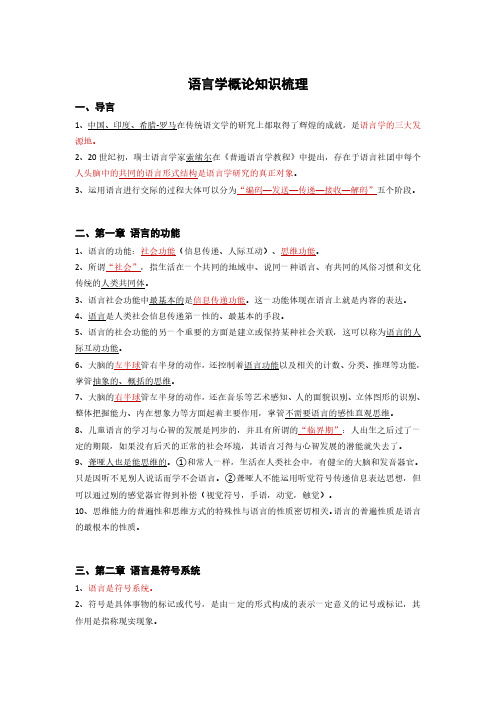
语言学概论知识梳理一、导言1、中国、印度、希腊-罗马在传统语文学的研究上都取得了辉煌的成就,是语言学的三大发源地。
2、20世纪初,瑞士语言学家索绪尔在《普通语言学教程》中提出,存在于语言社团中每个人头脑中的共同的语言形式结构是语言学研究的真正对象。
3、运用语言进行交际的过程大体可以分为“编码—发送—传递—接收—解码”五个阶段。
三、第二章语言是符号系统1、语言是符号系统。
2、符号是具体事物的标记或代号,是由一定的形式构成的表示一定意义的记号或标记,其作用是指称现实现象二、第一章语言的功能1、语言的功能:社会功能(信息传递、人际互动)、思维功能。
2、所谓“社会”,指生活在一个共同的地域中、说同一种语言、有共同的风俗习惯和文化传统的人类共同体。
3、语言社会功能中最基本的是信息传递功能。
这一功能体现在语言上就是内容的表达。
4、语言是人类社会信息传递第一性的、最基本的手段。
5、语言的社会功能的另一个重要的方面是建立或保持某种社会关联,这可以称为语言的人际互动功能。
6、大脑的左半球管右半身的动作,还控制着语言功能以及相关的计数、分类、推理等功能,掌管抽象的、概括的思维。
7、大脑的右半球管左半身的动作,还在音乐等艺术感知、人的面貌识别、立体图形的识别、整体把握能力、内在想象力等方面起着主要作用,掌管不需要语言的感性直观思维。
8、儿童语言的学习与心智的发展是同步的,并且有所谓的“临界期”:人出生之后过了一定的期限,如果没有后天的正常的社会环境,其语言习得与心智发展的潜能就失去了。
9、聋哑人也是能思维的。
①和常人一样,生活在人类社会中,有健全的大脑和发音器官。
只是因听不见别人说话而学不会语言。
②聋哑人不能运用听觉符号传递信息表达思想,但可以通过别的感觉器官得到补偿(视觉符号,手语,动觉,触觉)。
10、思维能力的普遍性和思维方式的特殊性与语言的性质密切相关。
语言的普遍性质是语言的最根本的性质。
3、符号包括形式和意义两方面,二者不可分离,相结合才构成符号,没有无意义的符号形式。
《语言学概论》期末试卷-语言学概论期末考试
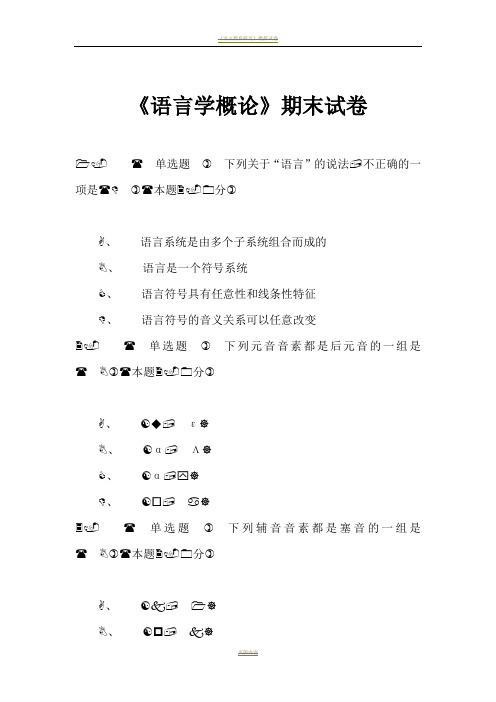
《语言学概论》期末试卷 ☎ 单选题 ✆ 下列关于“语言”的说法 不正确的一项是☎ ✆☎本题 分✆✌、 语言系统是由多个子系统组合而成的、 语言是一个符号系统、 语言符号具有任意性和线条性特征、 语言符号的音义关系可以任意改变 ☎ 单选题 ✆ 下列元音音素都是后元音的一组是☎ ✆☎本题 分✆✌、 ☯◆ ε、 ☯α Λ、 ☯α ⍓、 ☯☐ ♋ ☎ 单选题 ✆ 下列辅音音素都是塞音的一组是☎ ✆☎本题 分✆✌、 ☯ 、 ☯☐ 、 ☯☐ ⏹、 ☯♦ ❖ ☎ 单选题 ✆ 从语音的社会功能角度划分出来的最小语音单位是☎ ✌✆☎本题 分✆✌、 音位、 音素、 音节、 音渡 ☎ 单选题 ✆ 汉语普通话中的“我”和助词“的”单念时发音分别为☯◆☐和☯♦♏而在实际语流中 “我的”发音是☯◆☐ ♎♏这是语流音变中的☎ ✌✆☎本题 分✆✌、 顺同化现象、 逆同化现象、 弱化现象、 异化现象 ☎ 单选题 ✆ 语音的本质属性是☎ ✆☎本题 分✆✌、 物理属性、 生理属性、 心理属性 ☎ 单选题 ✆ 英语“♦♦◆♎♏⏹♦♦”中的“ ♦”是☎ ✆☎本题 分✆✌、 虚词语素、 词根语素、 构形语素、 构词语素 ☎ 单选题 ✆ 从词的构造方式看 下列各项中属于复合词的是☎ ✆☎本题 分✆✌、 木头、 念头、 苦头、 山头 ☎ 单选题 ✆ 划分词类的最本质的标准是☎✌ ✆☎本题 分✆✌、 分布标准、 意义标准、 形态标准 ☎ 单选题 ✆ 下面词组中 结构类型与其他各组不同的一组是☎ ✆☎本题 分✆✌、 年轻漂亮 朴素大方、 我们大家 首都北京、 铁路民航 工人农民、 贯彻执行 讨论研究 ☎ 单选题 ✆ 目前已知的最古老的拼音文字是☎ ✆☎本题 分✆✌、 古埃及文字、 古希腊文字、 腓尼基文字、 中国的甲骨文 ☎ 单选题 ✆ 判断两种话是不同语言还是同一种语言的不同方言应该主要参考☎ ✆☎本题 分✆✌、 相互理解程度、 语言结构的差异程度、 共同的历史文化传统和民族认同感、 地域临近程度 ☎ 单选题 ✆ 关于语音四要素 下列说法不正确的一项是☎ ✆☎本题 分✆✌、 音高变化是语调的主要构成要素、 能起区别语言意义作用的是绝对的音高、音强和音长 、 音长是由发音体振动的持续时间决定的、 音强是由发音体振动的振幅大小决定的 ☎ 单选题 ✆ 下列各项中 都是低元音的一组是☎ ✆☎本题 分✆✌、 ☯⍓ ✍、 ☯♋ Λ 、 ☯◆ ε、 ☯ Α α ☎ 单选题 ✆ 下列各组辅音中 发音部位相同的一组是☎ ✌✆☎本题 分✆✌、 ☯ η、 ☯❍ ⏹、 ☯⏹ η、 ☯☐ ☎ 单选题 ✆ 北京话“面”单念时读作☯❍♓✍⏹但“面包”却读作☯❍♓✍❍ ☐α◆这种语流音变现象是☎ ✆☎本题 分✆✌、 弱化、 增音、 同化、 异化 ☎ 单选题 ✆ 下列各组中 三个复合词构词类型不一致的一组是☎ ✌✆☎本题 分✆✌、 席卷 耳鸣 地震、 打倒 切断 推翻、 发光 散热 出气、 天地 欢乐 爱好 ☎ 单选题 ✆ 语法规则的“抽象性”是指☎✌ ✆☎本题 分✆✌、 对语言的结构和成分进行类的概括、 相同规则可在一个结构里重复使用、 语法规则之间可以相互推导和解释、 语法规则的发展变化过程十分缓慢 ☎ 单选题 ✆ 以下不属于语言学的三大发源地的是☎ ✆☎本题 分✆✌、 中国、 埃及、 印度、 希腊 罗马 ☎ 单选题 ✆ 汉语中的词类☎词的语法分类✆可以首先分出的两个大类是☎ ✆☎本题 分✆✌、 基本词和非基本词、 实词和虚词、 典型词和兼类词、 体词和谓词 ☎ 单选题 ✆ “汽车”和“卡车”是☎ ✌✆☎本题 分✆✌、 上下位词、 同义词、 等义词、 近义词 ☎ 单选题 ✆ 根据字符跟什么样的语言单位相联系的标准来分类 已知自源文字都属于☎ ✌✆☎本题 分✌✆✌、 词文字、 语素文字、 音节文字、 音位文字 ☎ 单选题 ✆ 在语言谱系分类的层级体系中 最大的类别是☎ ✆☎本题 分✆✌、 语族、 语支、 语系、 语群 ☎ 单选题 ✆ 语言符号的任意性是指☎ ✆☎本题 分✆✌、 语言符号可以任意使用和创造、 绝大多数语言符号的能指和所指之间没有必然的理据关系、 可以任意使用语言符号给事物命名、 语言符号的能指和所指可以任意改变 ☎ 单选题 ✆ 下列语言学流派中集中研究语言本体的流派是☎ ✆☎本题 分✆✌、 功能语言学、 社会语言学、 认知语言学、 结构语言学 ☎ 单选题 ✆ 英语动词“去”的原形是“♑☐” 过去时的形式是“♦♏⏹♦” 这在语法手段的词形变化中叫作☎ ✆☎本题 分✆✌、 附加、 屈折、 异根、 零形式 ☎ 多选题 ✆ 下列关于重音的表述 正确的是☎ ✌✆☎本题 分✆✌、 有些语言中一个词可以有一个以上的重音、 能够区别不同意义的重音可以看作一个音位、 汉语中有词重音、 重音跟音强的增加有关 ☎ 多选题 ✆ 对发音器官功能的描述 不正确的是☎✌ ✆☎本题 分✆✌、 声带在发音中的作用是次要的、 被动发音器官是不能自主运动的。
大学语言学试题
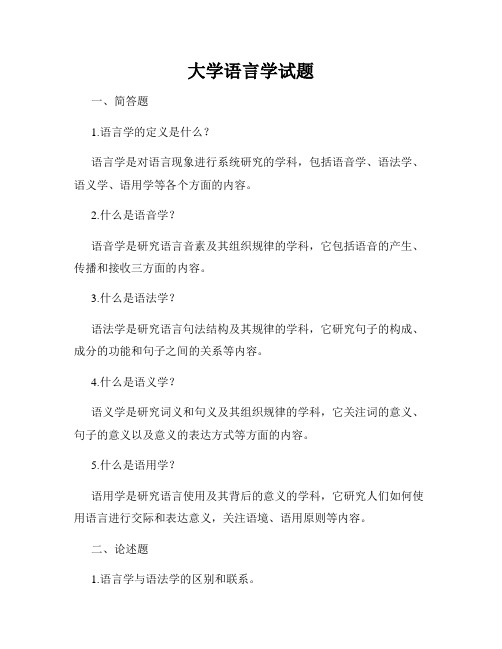
大学语言学试题一、简答题1.语言学的定义是什么?语言学是对语言现象进行系统研究的学科,包括语音学、语法学、语义学、语用学等各个方面的内容。
2.什么是语音学?语音学是研究语言音素及其组织规律的学科,它包括语音的产生、传播和接收三方面的内容。
3.什么是语法学?语法学是研究语言句法结构及其规律的学科,它研究句子的构成、成分的功能和句子之间的关系等内容。
4.什么是语义学?语义学是研究词义和句义及其组织规律的学科,它关注词的意义、句子的意义以及意义的表达方式等方面的内容。
5.什么是语用学?语用学是研究语言使用及其背后的意义的学科,它研究人们如何使用语言进行交际和表达意义,关注语境、语用原则等内容。
二、论述题1.语言学与语法学的区别和联系。
语言学是对语言现象进行全面研究的学科,涵盖了语音学、语法学、语义学和语用学等方面的内容。
而语法学是语言学的一个分支,主要研究语法现象及其规律。
语言学与语法学的联系在于语法学是语言学的重要组成部分,它提供了研究语言结构和规律的方法和理论基础。
同时,语法学的研究结果也为语言学的其他方面提供了重要的参考。
然而,语言学与语法学的区别在于语言学更加宏观和综合,它研究语言的各个方面,包括语音、词汇、句法、语义和语用等。
而语法学则是语言学中具体研究句法现象的一个分支,着重研究句子的构成、成分的功能和句子之间的关系。
2.语音学与音系学的关系。
语音学研究语音的产生、传播和接收,它是语言学的一个重要分支学科。
而音系学则是语音学中研究语言音素及其组织规律的一个分支领域。
语音学通过观察和记录语音现象,研究不同语音之间的差异和共性。
而音系学则在此基础上进一步研究语言中的音素及其分类、组织以及声音之间的相互关系。
简言之,语音学是对语音现象的整体研究,而音系学是语音学中对语音结构及其规律的具体研究。
三、分析题1.什么是语言的意义?语言的意义是指语言表达所传递的信息内容。
它涉及词汇意义、句子意义和话语意义等多个层次。
语言学概论期末复习精要语言学概论期末复习精要
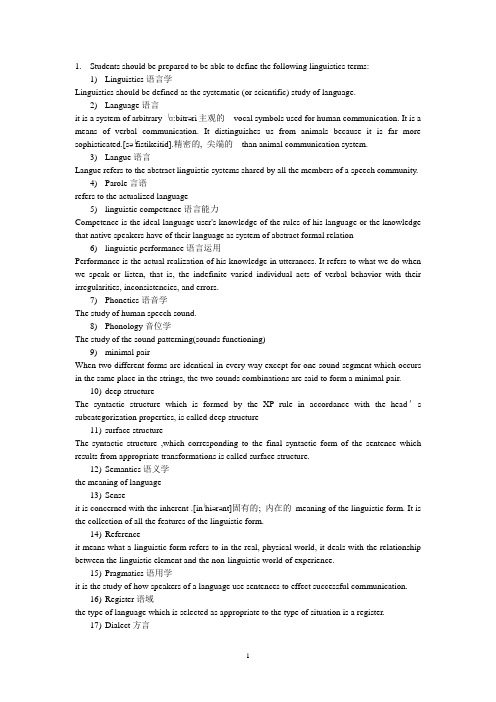
1.Students should be prepared to be able to define the following linguistics terms:1)Linguistics语言学Linguistics should be defined as the systematic (or scientific) study of language.2)Language语言it is a system of arbitrary ˈɑ:bitrəri主观的vocal symbols used for human communication. It is a means of verbal communication. It distinguishes us from animals because it is far more sophisticated.[səˈfistikeitid].精密的, 尖端的than animal communication system.3)Langue语言Langue refers to the abstract linguistic systems shared by all the members of a speech community.4)Parole言语refers to the actualized language5)linguistic competence语言能力Competence is the ideal language user's knowledge of the rules of his language or the knowledge that native speakers have of their language as system of abstract formal relation6)linguistic performance语言运用Performance is the actual realization of his knowledge in utterances. It refers to what we do when we speak or listen, that is, the indefinite varied individual acts of verbal behavior with their irregularities, inconsistencies, and errors.7)Phonetics语音学The study of human speech sound.8)Phonology音位学The study of the sound patterning(sounds functioning)9)minimal pairWhen two different forms are identical in every way except for one sound segment which occurs in the same place in the strings, the two sounds combinations are said to form a minimal pair.10)deep structureThe syntactic structure which is formed by the XP rule in accordance with the head’s subcategorization properties, is called deep structure11)surface structureThe syntactic structure ,which corresponding to the final syntactic form of the sentence which results from appropriate transformations is called surface structure.12)Semantics语义学the meaning of language13)Senseit is concerned with the inherent .[inˈhiərənt]固有的; 内在的meaning of the linguistic form. It is the collection of all the features of the linguistic form.14)Referenceit means what a linguistic form refers to in the real, physical world, it deals with the relationship between the linguistic element and the non-linguistic world of experience.15)Pragmatics语用学it is the study of how speakers of a language use sentences to effect successful communication.16)Register语域the type of language which is selected as appropriate to the type of situation is a register.17)Dialect方言A variety of a language used recognizably in a specific region or by a specific social class is called dialect.18)Acquisition获取First language acquisition refers to the child’s acquisition of his mother tongue. Second language acquisition refers to the systematic study of how one person acquires a second language subsequent to his native language.19)inter-lingual errorserrors result from language transfer, or caused by the learner’s mother tongue. i.e. caused by the learner’s NL e.g. “Elle regarde les”20)intra-lingual errorsThey mainly result form faulty or partial learning of the target language. It may be caused by the influence of one TL. Term upon another.21)applied linguisticsit refers to the application of linguistic theories, methods, and findings to the study of language learning and teaching22)the aptitude testit is designed to measure the learner’s aptitude or natural ability to learn languages.23)the achievement testit focus on assessing a testee’s mestery of the contents of a particular course.24)co-operative principleit refers to that the participants in a convasation normally communicate in a maximally efficient natual and cooperative way.2.Students should be able to answer the following questions:1)In what ways does modern linguistics differ from traditional grammar?The focus of research has been transformed from the language system to the use of language.The rise of the inter-displinery research and the borderline介于两者之间的subjects.2)For what reasons does modern linguistics give priority to speech rather than to writing? Speech is prior to writing;The writing system is invented when needed;Today there are languages which can only be spoken but not written;Speech plays a greater role than writing in daily communication;Each human being first acquires speech and then learns writing;Modern linguistics tends to pay more attention to authentic speech.3)What is a phone? How is it differ from a phoneme? How are allophones related to aphoneme?Phone is a phonetic unit or segment.These sounds we hear and produce during linguistic communication are all phones. A phoneme is a phonological unit . It is represented or realized by a certain phone in a certain phonetic context.in English the sounds (phones) that possess the distinctive value are called phonemes.Phonemes are said to be the distinctive sounds.4)What are the five sense relations between words? Please illustrate them. p1361. difference in origin answer-reply;2. difference in the shades不同程度的of meaning;3. difference in socio-expressive meaning;4. difference in stylistic meaning;5. difference in collocation and distribution.5)According to Austin, what are the three acts a person is possibly performing whilemaking an utterance? Give an example.locutionary act (言内行为) illocutionary act(言外行为) perlocutionary act(言后行为)“Good Morning!What did he do ?”He produced a sound, word, or sentence.The act performed in this sense is called locutionary act.言内行为He offered a greeting. illocutionary act言外行为. Locationary act (言内行为) is the act of saying something . It is an act of conveying literal meaning by means of syntax, lexicon and phonology.E.g. “John, it’s very cold outside! ”母亲说出这句话的本身就是言内行为;母亲说出这句话的意图是为了让JOHN穿上大衣再出去,这是言外行为;JOHN听了母亲的话后,穿上大衣在出门,这就是言后行为。
语言学概论期末考试试卷与答案
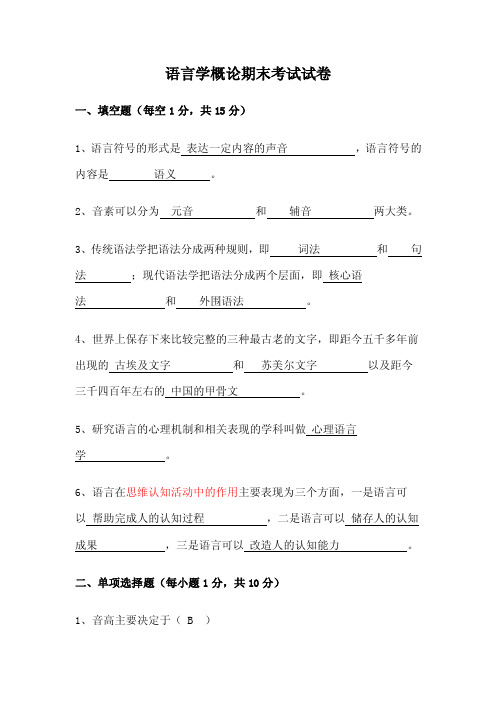
语言学概论期末考试试卷一、填空题(每空1分,共15分)1、语言符号的形式是表达一定内容的声音,语言符号的内容是语义。
2、音素可以分为元音和辅音两大类。
3、传统语法学把语法分成两种规则,即词法和句法;现代语法学把语法分成两个层面,即核心语法和外围语法。
4、世界上保存下来比较完整的三种最古老的文字,即距今五千多年前出现的古埃及文字和苏美尔文字以及距今三千四百年左右的中国的甲骨文。
5、研究语言的心理机制和相关表现的学科叫做心理语言学。
6、语言在思维认知活动中的作用主要表现为三个方面,一是语言可以帮助完成人的认知过程,二是语言可以储存人的认知成果,三是语言可以改造人的认知能力。
二、单项选择题(每小题1分,共10分)1、音高主要决定于( B )A.发音体振动的振幅 B.发音体振动的频率C.发音体振动的时间 D.发音体振动的声波形式2、最小的有意义的能独立使用的语言单位是( B )A.语素 B.词 C.词组 D.句子3、“的”字词组相当于( A )A.名词的词组 B.动词的词组 C.形容词的词组 D.介词词组4、人们在反映现实现象的同时,还可能表现出对该现象的主观态度,从而在词的理性意义上增添了一层附加色彩,这种色彩是(A )A.感情色彩 B.语体色彩 C.形象色彩 D.音响色彩5、有的述谓结构的变元本身是一个述谓结构,这种充当其他谓词变元的述谓结构就是( C )A.简单述谓结构B.复合述谓结构C.从属述谓结构D.降级述谓结构6、阿拉伯文字是( A )A.辅音文字 B.音节文字 C.表意文字 D.意音文字7、语言是一种( B )A.心理现象 B.社会现象 C.物理现象 D.生理现象8、语素分类中最大的类是( C )A.语族 B.语支 C.语系 D.语群9、下列词语中属于借词的是( A )A.摩登 B.妯娌 C.把戏 D.马虎10、语言是思维的工具指的是( B )A.一切思维必须由语言完成B.主要指抽象思维和其他思维高级阶段离不开语言C.主要指感性思维和发散思维离不开语言D.先有语言后有思维三、名词解释(每小题4分,共16分)1、音位2、组合规则3、语法手段4、抽象思维四、简答题(每小题7分,共21分)1、人类语言的起源必须具备哪三方面的条件?1、答:首先,人类的思维能力要发展到一定的水平,应该能够对客观世界的事物进行分类和概括,并具有一定的记忆和想象、判断和推理的能力,只有具备了这样的心理条件才有可能产生语言。
语言学纲要 期末复习资料(题库)

语言学概论试题(1)一、填空15%1、语言中最单纯、最常用、最原始和最能产的词是根词。
2、语言是人类最重要的交际工具,文字是最重要的辅助交际工具。
3、我国古代学者为读懂古书而建立的训诂学、文字学、音韵学组成了我国的语文学,通称为“小学”。
4、英语属于印欧语系的日耳曼语族的西部语支。
5、语音可以从生理角度分析它的产生方式,从物理角度分析它的表现形式(传递过程),从社会功能角度分析它的功能作用。
6、是否能够独立(自由)运用,是区分词和语素的根本特点。
7、现代大多数国家的拼音文字的字母,大多直接来源于拉丁字母。
8、具有不同功能的三种最基本的语法单位是语素、词、句子。
9、语言发展的主要特点是渐变性和不平衡性。
10、我国宪法(1982年)第19条明确规定“国家推广全国通用的普通话”。
二、选择题10%1 、中国的传统语文学研究的薄弱环节是(D )A、文字学B、语音学C、词汇学D、语法学2、汉语属于(B )A、屈折语B、词根语C、多式综合语D、粘着语3、一种语言中数量最少的是(B )A、音素B、音位C、语素D、音节4、文字的前身是(C )A、结绳记事B、手势C、图画记事D、实物记事5、派生词中包含(B )A、词尾B、词根C、虚词D、根词6、语音和语义结合的最小的语言单位是(C )A、音素B、义素C、语素D、音位7、汉语单词“忽然”出现的位置是(C )A、主语位置B、谓语位置C、状语位置D、定语位置8、以下各种语言变体中,属于社会方言的是(D )A、土话B、客家话C、客套话D、黑话9、下列语素中属于自由语素的是(C )A、初B、视C、人D、民10、在语言结构的某一环节上能够互相替换,具有某种相同作用的各个单位之间所形成的关系叫(D )A、转换关系B、组合关系C、层级关系D、聚合关系三、名词解释20%1、专语语言学: 以具体语言作为研究对象的语言学。
2、组合关系: 指两个以上相连续的语言符号组合而成的线性关系。
3、语流音变:语流中的某些音由于相互影响而发生临时性的变化,这种变化就叫语流音变。
语言学概论试题答案
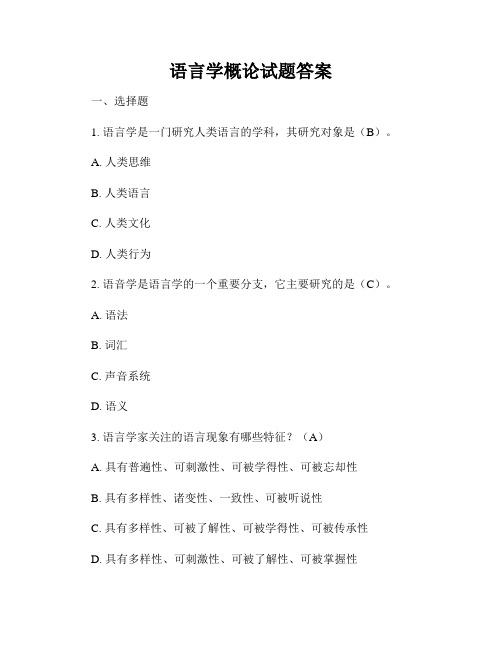
语言学概论试题答案一、选择题1. 语言学是一门研究人类语言的学科,其研究对象是(B)。
A. 人类思维B. 人类语言C. 人类文化D. 人类行为2. 语音学是语言学的一个重要分支,它主要研究的是(C)。
A. 语法B. 词汇C. 声音系统D. 语义3. 语言学家关注的语言现象有哪些特征?(A)A. 具有普遍性、可刺激性、可被学得性、可被忘却性B. 具有多样性、诸变性、一致性、可被听说性C. 具有多样性、可被了解性、可被学得性、可被传承性D. 具有多样性、可刺激性、可被了解性、可被掌握性4. 语言是人类思维的外在表现,它的特点包括(B)。
A. 符号性、逻辑性、经验性、情感性B. 音素性、词汇性、语法性、交际性C. 语音性、声调性、音节性、语义性D. 文化性、习得性、传承性、社会性5. 语言学的研究方法主要包括哪些方面?(D)A. 观察法、统计法、实验法、调查法B. 比较法、分析法、综合法、实证法C. 形态法、句法法、语义法、语用法D. 理论法、实证法、历时法、内在法二、简答题1. 什么是语音学?简述语音学的基本研究对象。
语音学是语言学的一个分支学科,主要研究的是语言中声音的产生、传播和感知机制。
它研究的基本对象是语音。
语音是一种由声音信号组成的符号系统,通过声音的不同组合和规则,人们能够进行语言的交际和沟通。
2. 语言学的研究范围包括哪些方面?简要描述其中两个方面的内容。
语言学的研究范围涵盖了语音、词汇、语法、语义和语用等多个方面。
其中语音学主要研究语言中的声音系统,通过研究语音的音素、音位和音系等要素来揭示其规律和变化。
而语法学研究语言中的句子构成和组合规律,包括短语结构、词类、句法关系等内容。
三、论述题语言作为人类最为基本的交流工具和思维表达方式,对于人类社会和文化的发展起到了重要的作用。
语言学作为一门学科,对于深入研究和探索语言的本质和规律具有重要意义。
首先,语言学研究语言的普遍性和多样性。
语言在世界各地的人类社会中普遍存在,但不同语言之间又表现出多样性。
语言学概论-语言学概论期末考试及答案三
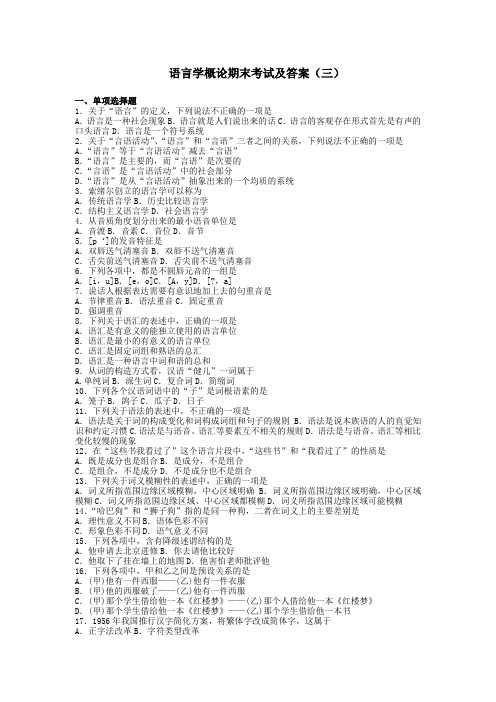
语言学概论期末考试及答案(三)一、单项选择题1.关于“语言”的定义,下列说法不正确的一项是A.语言是一种社会现象B.语言就是人们说出来的话C.语言的客观存在形式首先是有声的口头语言D.语言是一个符号系统2.关于“言语活动”、“语言”和“言语”三者之间的关系,下列说法不正确的一项是A.“语言”等于“言语活动”减去“言语”B.“语言”是主要的,而“言语”是次要的C.“言语”是“言语活动”中的社会部分D.“语言”是从“言语活动”抽象出来的一个均质的系统3.索绪尔创立的语言学可以称为A.传统语言学B.历史比较语言学C.结构主义语言学D.社会语言学4.从音质角度划分出来的最小语音单位是A.音渡B.音素C.音位D.音节5.[p‘]的发音特征是A.双唇送气清塞音B.双唇不送气清塞音C.舌尖前送气清塞音D.舌尖前不送气清塞音6.下列各项中,都是不圆唇元音的一组是A.[i,u]B.[e,o]C.[A,y]D.[?,a]7.说话人根据表达需要有意识地加上去的句重音是A.节律重音B.语法重音C.固定重音D.强调重音8.下列关于语汇的表述中,正确的一项是A.语汇是有意义的能独立使用的语言单位B.语汇是最小的有意义的语言单位C.语汇是固定词组和熟语的总汇D.语汇是一种语言中词和语的总和9.从词的构造方式看,汉语“健儿”一词属于A.单纯词B.派生词C.复合词D.简缩词10.下列各个汉语词语中的“子”是词根语素的是A.笼子B.鸽子C.瓜子D.日子11.下列关于语法的表述中,不正确的一项是A.语法是关于词的构成变化和词构成词组和句子的规则B.语法是说本族语的人的直觉知识和约定习惯C.语法是与语音、语汇等要素互不相关的规则D.语法是与语音、语汇等相比变化较慢的现象12.在“这些书我看过了”这个语言片段中,“这些书”和“我看过了”的性质是A.既是成分也是组合B.是成分,不是组合C.是组合,不是成分D.不是成分也不是组合13.下列关于词义模糊性的表述中,正确的一项是A.词义所指范围边缘区域模糊,中心区域明确B.词义所指范围边缘区域明确,中心区域模糊C.词义所指范围边缘区域、中心区域都模糊D.词义所指范围边缘区域可能模糊14.“哈巴狗”和“狮子狗”指的是同一种狗,二者在词义上的主要差别是A.理性意义不同B.语体色彩不同C.形象色彩不同D.语气意义不同15.下列各项中,含有降级述谓结构的是A.他申请去北京进修B.你去请他比较好C.他取下了挂在墙上的地图D.他害怕老师批评他16.下列各项中,甲和乙之间是预设关系的是A.(甲)他有一件西服——(乙)他有一件衣服B.(甲)他的西服破了——(乙)他有一件西服C.(甲)那个学生借给他一本《红楼梦》——(乙)那个人借给他一本《红楼梦》D.(甲)那个学生借给他一本《红楼梦》——(乙)那个学生借给他一本书17.1956年我国推行汉字简化方案,将繁体字改成简体字,这属于A.正字法改革B.字符类型改革C.文字类型改革D.字符类型和文字类型改革18.汉语中的“基因”来自英语的gene,从该词产生的方式看,“基因”属于A.纯粹音译词B.音译兼意译词C.意译词D.仿译词19.从语言的发展演变来看,语汇系统中最不易发生变化的是A.通用语汇B.常用语汇C.基本语汇D.专用语汇20.关于社会方言的形成,下列说法不正确的一项是A.社会方言大多是在语言的相互接触中形成的B.社会方言是随着社会的社群分化而产生的C.一种语言的内部有可能形成社会方言D.一种方言的内部有可能形成社会方言21.关于共同语的形成,下列说法不正确的一项是A.并不意味着方言分歧已经消失B.并不意味着方言分歧将会扩大C.并不意味着方言最终将被取代D.并不意味着语言已经实现统一22.关于语言规范化的推行,下列说法不正确的一项是A.主要由权威机构提出具体的规范意见B.主要由权威机构强制推行C.主要通过教育机构、大众传媒等渠道向社会推行D.主要是一个积极引导社会公众自觉遵守的过程23.关于语言获得的原因,下列学说中偏重于内部条件解释的是A.模仿说B.天赋说C.强化说D.刺激反应说24.基本上不能说话,但仍能听懂别人说话,这种症状的失语症是A.失读症B.布洛卡失语症C.失名症D.维尔尼克失语症25.关于“中介语”现象,下列说法不正确的一项是A.“中介语”既不同于母语又不同于外语B.“中介语”是不断地从母语向外语靠近的语言形式C.即使是较高级的“中介语”也不能用于交际D.“中介语”越到外语学习后期发展就越慢26.词典最常见的分类是A.语言词典和历史词典B.描写词典和历史词典C.百科词典和历史词典D.百科词典和语言词典二、多项选择题27.语流中有些音在发音上变弱,这种现象叫弱化。
语言学概论期末作业答案(1)
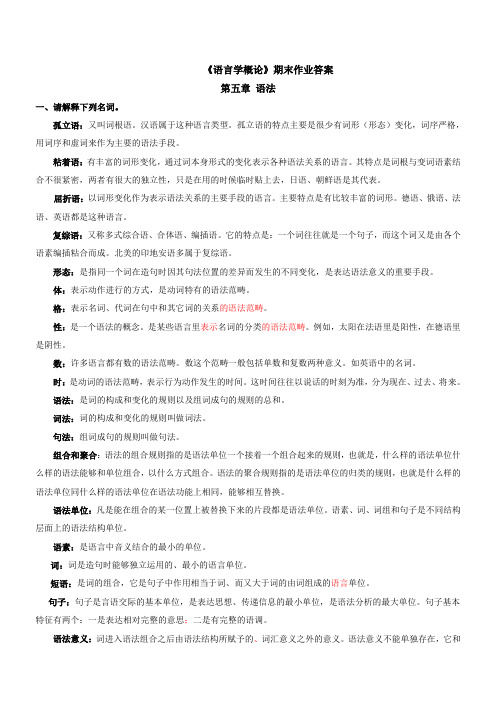
《语言学概论》期末作业答案第五章语法一、请解释下列名词。
孤立语:又叫词根语。
汉语属于这种语言类型。
孤立语的特点主要是很少有词形(形态)变化,词序严格,用词序和虚词来作为主要的语法手段。
粘着语:有丰富的词形变化,通过词本身形式的变化表示各种语法关系的语言。
其特点是词根与变词语素结合不很紧密,两者有很大的独立性,只是在用的时候临时贴上去,日语、朝鲜语是其代表。
屈折语:以词形变化作为表示语法关系的主要手段的语言。
主要特点是有比较丰富的词形。
德语、俄语、法语、英语都是这种语言。
复综语:又称多式综合语、合体语、编插语。
它的特点是:一个词往往就是一个句子,而这个词又是由各个语素编插粘合而成。
北美的印地安语多属于复综语。
形态:是指同一个词在造句时因其句法位置的差异而发生的不同变化,是表达语法意义的重要手段。
体:表示动作进行的方式,是动词特有的语法范畴。
格:表示名词、代词在句中和其它词的关系的语法范畴。
性:是一个语法的概念。
是某些语言里表示名词的分类的语法范畴。
例如,太阳在法语里是阳性,在德语里是阴性。
数:许多语言都有数的语法范畴。
数这个范畴一般包括单数和复数两种意义。
如英语中的名词。
时:是动词的语法范畴,表示行为动作发生的时间。
这时间往往以说话的时刻为准,分为现在、过去、将来。
语法:是词的构成和变化的规则以及组词成句的规则的总和。
词法:词的构成和变化的规则叫做词法。
句法:组词成句的规则叫做句法。
组合和聚合:语法的组合规则指的是语法单位一个接着一个组合起来的规则,也就是,什么样的语法单位什么样的语法能够和单位组合,以什么方式组合。
语法的聚合规则指的是语法单位的归类的规则,也就是什么样的语法单位同什么样的语法单位在语法功能上相同,能够相互替换。
语法单位:凡是能在组合的某一位置上被替换下来的片段都是语法单位。
语素、词、词组和句子是不同结构层面上的语法结构单位。
语素:是语言中音义结合的最小的单位。
词:词是造句时能够独立运用的、最小的语言单位。
《语言学概论》期末题库

《语言学概论》期末题库一、选择题(每小题2分,共60分。
)1.下列词组只有( )没有歧义。
A.两个朋友送的花瓶B.折断了猎人的枪C.看打球的小女孩D.发现了敌人的哨兵2.语法上所谓“体”的范畴是指()。
A.用词的形态变化表示动作进行的状态B.口语体C.书面体D.用词的形态变化表示待人接物的状态3.我们在念“老虎”时,通常要把“老”念成阳平,这种变化叫做()。
A.同化B.异化C.弱化D.脱落4.下列各组词其构词类型都属于复合词的是()A.领导大街reader B.国家月球railwayC.老师刷子unlike D.考虑作家classmate5.俄语、汉语、日语三种语言所属的语法结构类型按次序是()A.粘着语-屈折语-孤立语B.屈折语-粘着语-孤立语C.孤立语-屈折语-粘着语D.屈折语-孤立语-粘着语6.与“春光明媚”结构相同的组合是()A.阳光的温暖B.马上开始C.太阳出来. D.农民和工人7.“年龄”和“岁数”在非理性意义上的主要差别是()A.感情色彩不同B.语体色彩不同C.形象色彩不同D.语气意义不同8.语言中发展演变速度最快的是()A.语法规则B.音位系统C.一般语汇D.基本语汇9.英语名词后面加上s或es,这种变化属于语法范畴中的( )变化。
A.性 B.数 C.格 D.体10.下列说法,只有()正确。
A.振幅越大,声音就越弱。
B.振幅越大,声音就越长。
C.频率越大,声音就越低。
D.频率越大,声音就越高。
11.关于元音和辅音的区别的描述,()是正确的。
A.元音发音时间短暂,辅音发音时间较长。
B.辅音发音响亮,元音发音不响亮。
C.发辅音气流受阻,发元音气流不受阻。
D.发元音和辅音发音器官的各个部位均衡紧张。
12.下列各组元音区别的描述,()是错误的。
A.[i]和[y]的区别是舌位前后不同。
B.[u]和[o]的区别是舌位高低不同。
C.[a]和[ɑ] 的区别是舌位前后不同。
D.i和a的区别是舌位高低不同。
语言学全部习题
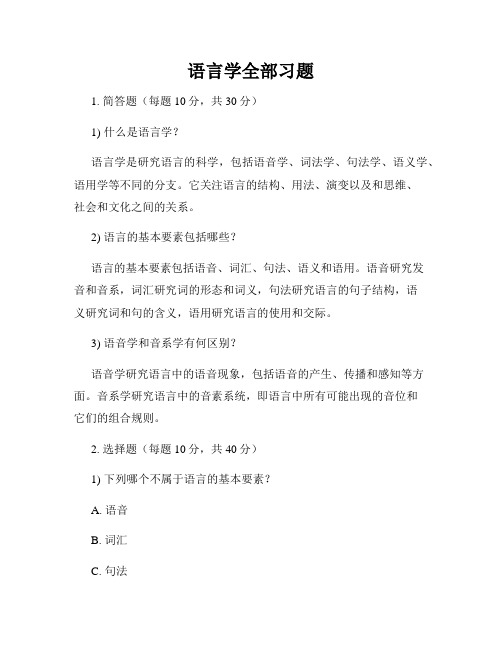
语言学全部习题1. 简答题(每题10分,共30分)1) 什么是语言学?语言学是研究语言的科学,包括语音学、词法学、句法学、语义学、语用学等不同的分支。
它关注语言的结构、用法、演变以及和思维、社会和文化之间的关系。
2) 语言的基本要素包括哪些?语言的基本要素包括语音、词汇、句法、语义和语用。
语音研究发音和音系,词汇研究词的形态和词义,句法研究语言的句子结构,语义研究词和句的含义,语用研究语言的使用和交际。
3) 语音学和音系学有何区别?语音学研究语言中的语音现象,包括语音的产生、传播和感知等方面。
音系学研究语言中的音素系统,即语言中所有可能出现的音位和它们的组合规则。
2. 选择题(每题10分,共40分)1) 下列哪个不属于语言的基本要素?A. 语音B. 词汇C. 句法D. 语文答案:D2) 以下哪个学科不是语言学的分支?A. 语音学B. 语用学C. 数学D. 词法学答案:C3) 语音学主要研究哪方面的内容?A. 词义B. 词形C. 词语的使用D. 语音的产生和感知答案:D4) 以下哪个不是语言学的研究对象?A. 词汇表B. 句子结构C. 语言和思维的关系D. 社会语言规范答案:A3. 简答题(每题10分,共30分)1) 什么是语言的演变?语言的演变是指语言在使用过程中,由于多种因素的影响,其语音、词汇、句法等方面发生变化和发展。
语言的演变是一个长期的、渐进的过程,涉及到语言交流者的语言习惯、语音产生的方式、语法规则的改变等方面的变化。
2) 语言和思维之间有何关系?语言和思维之间有密切的关系。
一方面,语言是人类思维的表达工具,通过语言的运用,人们能够将思维中的概念、情感和意图等传递给他人。
另一方面,语言也影响思维的方式和内容。
语言结构和词汇的差异会影响人们的思维方式,不同语言对概念的划分和认知方式可能会有所不同。
3) 什么是语言交际?语言交际指的是人们通过语言进行沟通和交流的过程。
语言交际包括语言的使用、理解和解释,以及交流中的非语言行为和语境等因素。
语言学纲要期末复习材料(叶蜚声 徐通锵编)-精华.

语言学概论导言部分中国、印度、希腊-罗马是语言学的三大发源地我国传统小学包括文字、音韵、训诂三门分支学科。
语言交际过程可分“编码-发送-传递-接收-解码”五个阶段。
20世纪初,瑞士语言学家索绪尔在《普通语言学教程》中提出,存在于语言社团中每个人头脑中的共同的语言形式结构是语言学研究的真正对象。
语言学从此成为一门现代科学。
第一章语言的功能信息传递功能语言的社会功能人际互动功能语言的功能语言的思维功能说话中枢(布洛卡区)-左半球前部-失语症(丧失说话能力,听得懂)书写中枢-靠近布洛卡区-失写症(失去写字绘画等精细动作能力)人类大脑特有的语言功能分区视觉性语言中枢-左半球后部-失读症(无法阅读理解)听觉型语言中枢(韦尼克区)-左半球后部-感觉性失语症(听得到但听不懂,也表达不清)为什么说语言是人类社会信息传递第一性的,最基本的手段?①人类传递信息,进行交际和交流思想,除了使用语言外,还可以使用文字、旗语、红绿灯、电报代码、数学符号以及身势、表情等。
在一定场合使用,可以弥补语言的一些不足,但是这些交际工具使用范围有限,有的仅用于特定的范围。
②最重要的是,这些交际工具,都离不开语言,都是在语言的基础上产生的,是辅助语言进行交际的,没有语言,这些手段的存在没有任何意义。
A.语言是第一性的,文字是第二性的,文字是对语言的再编码系统,只有几千年历史。
B.旗语之类的则是建立在语言或文字基础之上的再编码形式。
C.身势所能传递信息十分有限,还可能被错误理解。
加第二章语言是符号系统1、为什么说语言是符号?语言符号和一般符号有什么不同?符号是由形式和意义两个部分构成的结合体。
说语言也是一种符号,是因为语言具有符号的一切特点:①语言之所以是一种符合,就是因为它能代表或指称现实现象。
②语言具有符号的一般特点,也有形式和意义两个方面:语言符号的第一性的形式是人类发出的声音,语言符号的意义是对它所指代的一类心理现实的概括。
③同一般符号一样,语言符号的音义结合是社会约定俗成的。
语言学纲要期末考试题
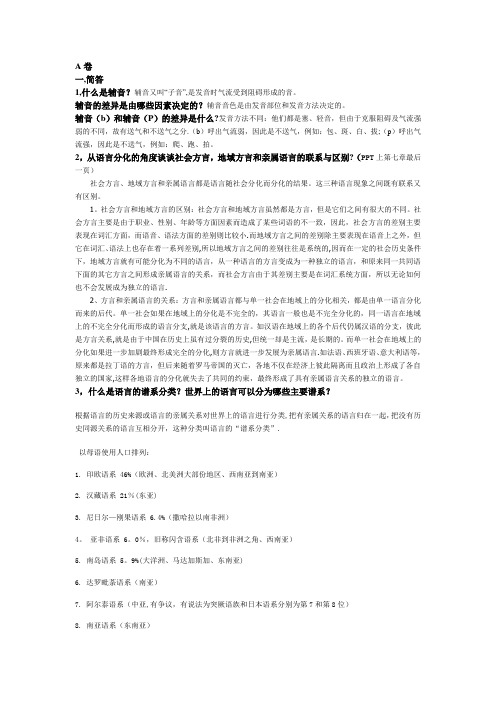
A卷一,简答1,什么是辅音?辅音又叫“子音”,是发音时气流受到阻碍形成的音。
辅音的差异是由哪些因素决定的?辅音音色是由发音部位和发音方法决定的。
辅音(b)和辅音(P)的差异是什么?发音方法不同:他们都是塞、轻音,但由于克服阻碍及气流强弱的不同,故有送气和不送气之分.(b)呼出气流弱,因此是不送气,例如:包、斑、白、拔;(p)呼出气流强,因此是不送气,例如:爬、跑、拍。
2,从语言分化的角度谈谈社会方言,地域方言和亲属语言的联系与区别?(PPT上第七章最后一页)社会方言、地域方言和亲属语言都是语言随社会分化而分化的结果。
这三种语言现象之间既有联系又有区别。
1。
社会方言和地域方言的区别:社会方言和地域方言虽然都是方言,但是它们之间有很大的不同。
社会方言主要是由于职业、性别、年龄等方面因素而造成了某些词语的不一致,因此,社会方言的差别主要表现在词汇方面,而语音、语法方面的差别则比较小.而地域方言之间的差别除主要表现在语音上之外,但它在词汇、语法上也存在着一系列差别,所以地域方言之间的差别往往是系统的,因而在一定的社会历史条件下,地域方言就有可能分化为不同的语言,从一种语言的方言变成为一种独立的语言,和原来同一共同语下面的其它方言之间形成亲属语言的关系,而社会方言由于其差别主要是在词汇系统方面,所以无论如何也不会发展成为独立的语言.2、方言和亲属语言的关系:方言和亲属语言都与单一社会在地域上的分化相关,都是由单一语言分化而来的后代。
单一社会如果在地域上的分化是不完全的,其语言一般也是不完全分化的,同一语言在地域上的不完全分化而形成的语言分支,就是该语言的方言。
如汉语在地域上的各个后代仍属汉语的分支,彼此是方言关系,就是由于中国在历史上虽有过分裂的历史,但统一却是主流,是长期的。
而单一社会在地域上的分化如果进一步加剧最终形成完全的分化,则方言就进一步发展为亲属语言.如法语、西班牙语、意大利语等,原来都是拉丁语的方言,但后来随着罗马帝国的灭亡,各地不仅在经济上彼此隔离而且政治上形成了各自独立的国家,这样各地语言的分化就失去了共同的约束,最终形成了具有亲属语言关系的独立的语言。
语言学简答(期末)
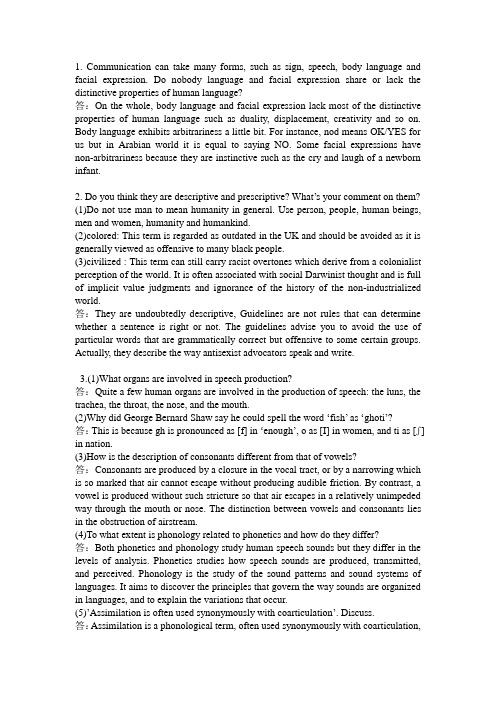
1. Communication can take many forms, such as sign, speech, body language and facial expression. Do nobody language and facial expression share or lack the distinctive properties of human language?答:On the whole, body language and facial expression lack most of the distinctive properties of human language such as duality, displacement, creativity and so on. Body language exhibits arbitrariness a little bit. For instance, nod means OK/YES for us but in Arabian world it is equal to saying NO. Some facial expressions have non-arbitrariness because they are instinctive such as the cry and laugh of a newborn infant.2. Do you think they are descriptive and prescriptive? What’s your comment on them?(1)Do not use man to mean humanity in general. Use person, people, human beings, men and women, humanity and humankind.(2)colored: This term is regarded as outdated in the UK and should be avoided as it is generally viewed as offensive to many black people.(3)civilized : This term can still carry racist overtones which derive from a colonialist perception of the world. It is often associated with social Darwinist thought and is full of implicit value judgments and ignorance of the history of the non-industrialized world.答:They are undoubtedly descriptive, Guidelines are not rules that can determine whether a sentence is right or not. The guidelines advise you to avoid the use of particular words that are grammatically correct but offensive to some certain groups. Actually, they describe the way antisexist advocators speak and write.3.(1)What organs are involved in speech production?答:Quite a few human organs are involved in the production of speech: the luns, the trachea, the throat, the nose, and the mouth.(2)Why did George Bernard Shaw say he could spell the word ‘fish’ as ‘ghoti’?答:This is because gh is pronounced as [f] in ‘enough’, o as [I] in women, and ti as [ʃ] in nation.(3)How is the description of consonants different from that of vowels?答:Consonants are produced by a closure in the vocal tract, or by a narrowing which is so marked that air cannot escape without producing audible friction. By contrast, a vowel is produced without such stricture so that air escapes in a relatively unimpeded way through the mouth or nose. The distinction between vowels and consonants lies in the obstruction of airstream.(4)To what extent is phonology related to phonetics and how do they differ?答:Both phonetics and phonology study human speech sounds but they differ in the levels of analysis. Phonetics studies how speech sounds are produced, transmitted, and perceived. Phonology is the study of the sound patterns and sound systems of languages. It aims to discover the principles that govern the way sounds are organized in languages, and to explain the variations that occur.(5)’Assimilation is often used synonymously with coarticulation’. Discuss.答:Assimilation is a phonological term, often used synonymously with coarticulation,which is more of a phonetic term. Similarly, there are two possibilities of assimilation: if a following sound is influencing a preceding sound, we call it regressive assimilation; the converse process, in which a preceding sound is influencing a following sound, is known as progressive assimilation.(6)The pronunciation of tell is [tɛ], but that of teller is [tɛlɚ]. Discuss why the phoneme/l/ is realized as [ɛ] and [l] respectively in this situation.答:The world teller is formed by adding a suffix –er to the base word tell to form a new word. We are all familiar with the rule that governs the allophones of the phoneme /l/: when preceding a vowel, it is [l] and when following a vowel it is [ɛ]. We notice that tell is a monosyllabic word while teller is disyllabic. In a polysyllabic word, we follow the Maximal Onset Principle for division of syllable. By MOP, the [l] must be placed in the onset position of the second syllable instead of the coda position of the first syllable. Thus, the phoneme [l] is realized as it should be before the vowel in the second syllable. The same is true with telling, falling, and many others.4.The following words contain different forms of the negative prefix in-. Group the data according to the variants and try to determine which kinds of base word take which kinds of prefix variant and what kind of mechanism is word responsible for the variation. Formulate a rule and then test it against words that are formed in this way but are not mentioned here.答:There are five groups of words according to their variation on pronunciation: [In]: inharmonic, ingenious, inoffensive, indifferent, inevitable, innumerable; [In] or [Iŋ]: incomprehensible, incompetent, inconsistent; [Im]: impenetrable, impossible, immobile; [Il]: illiterate, illegal, illogical; [Ir]: irresponsible, irresistible, irregular. It is clear that the first sound of the base word governs the distribution of the variants, because the final consonant of the prefix in- must assimilate to the first segment of the base word. As a result of this, we find [Im]before labial consonants like [m] or [p], [Il] before the lateral [I], [Ir] before [r]. When the first consonant of the base word is the velar consonant [k], it is [Iŋ] in rapid speech and [In] in careful speech. In all other cases [In] is always the case.5.For each of the underlined constructions or word groups, do the following. State whether it is headed or non-headed. If headed, state its headword. Name the type of constructions.(a)Ducks quack.答:non-headed, independent clause(b)The ladder in the shed is long enough.答:non-head, prepositional phrase.(c)I saw a bridge damaged beyond repair.答:headed; headword-damaged; adjectival group(d)Singing hymns is forbidden in some countries.答:headed; headword-singing; gerundial phrase.(e)His handsome face appeared in the magazine. A lady of great beauty came out.答:headed; headword-face; nominal group.(f)He enjoys climbing high mountains.答:non-headed; prepositional phrase.(h)The man nodded patiently.答:non-headed; independent clause.(i)A man roused by the insult drew his sword.答:headed; headword-roused. Adjectival phrase.6. Analyse the poem below from the semantic point of view, taking a special account of sense relations.答:This poem is about the use of the word ‘colored’. The author cleverly makes use of ‘colored’ in the sense of ‘different colors’ to oppose the proactive to refer to black people as ‘colored’. This shows from another point of view that ‘colored’is not a superordinate to ‘red’, ‘green’, ‘yellow’, etc.7. Some people maintain that there are no true synonyms. If two words mean really the same, one of them will definitely die out. An example often quoted is the disuse of the word ‘wireless’, which has been replaced by ‘radio’. Do you agree? In general what type of meaning we are talking about when we say two words are synonymous with each other?答: It is true that there are no absolute synonyms. When we say two words are synonymous with each other, we usually mean they have the same conceptual meaning.8.The British linguist ……We can treat male/female, married/single, alive/dead as gradable antonyms on occasions. Someone can be very male or more married and certainly more dead than alive. Comment on it.答:It is not advisable to tell beginners of linguistics that the distinction between gradable antonyms and complementary antonyms is relative. The expression ‘more dead that alive’ is not a true comparative.9.If you ask somebody ‘Can you open the door?’he answers ‘Yes’but does not actually do it, what would be your action? Why? Try to see it in the light of speech act theory.答:I would be angry with him. ‘Can you open the door’ is normally a request of the hearer to do it rather than a question about his ability. The fact that he answers ‘Yes’but does not actually do it shows that he declines my request.10. A is reading the newspaper. When B asks ‘What’s on TV tonight?’he answers ‘Nothing.’ What does A mean in normal situations? Think of two situations in which this interpretation of ‘Nothing’ will be cancelled.答:Normally ‘Nothing’ here means ‘Nothing interesting,’ If A adds after ‘Nothing’‘The workers are on strike’or ‘There’s going to be a blackout tonight’, then the interpretation of ‘Nothing interesting’ will be cancelled.。
语言学期末

语言学期末(这份是正确的)(总10页)-本页仅作为预览文档封面,使用时请删除本页-一. What is language?1. Language can be generally defined as a system of arbitrary vocal symbols used for human communication.Systematic---- rule-governed, elements in it are arranged according to certain rules; can’t be combined at will. . *bkli, *I apple eat.Arbitrary---- no intrinsic connection between the word and the thing it denotes, . “pen” by any other name is the thing we use to write with.Symbolic---- words are associated with objects, actions ideas by convention. “A rose by any other name would smell as sweet”----ShakespeareVocal---- the primary medium is sound for all languages; writing system came much later than spoken form.Human-specific---- different from the communication systems other forms of life possess, . bird songs, bee dance, animal cries.The design/defining /distinctive features of human language:Arbitrariness (任意性)Productivity/Creativity(创造性)Duality (二元性、二层性)Displacement (移位性)Cultural transmission(文化传递性)2.语言&言语Langue--- the language system shared by a community of speakersParole--- the concrete act of speaking in actual situations by an individual speaker.3. Synchronic vs. diachronicSynchronic (linguistics)---languages are studied at a theoretic point in time: one describes a ‘state’ of language, disregarding whatever changes might be taking place.Diachronic----languages are studied from point of view of their historical development – for example, the changes which have taken place between Old and Modern English could be described in phonological, grammatical and semantic terms.二.语音学(选择题)三.音位学 Phonology1.音位变体Allophones ---- the phones that can represent a phoneme in different phonetic environments.同一音位在不同环境中表现出来的两个或多个语音上不同的音段. 例如,在英语里,音位/t/在tin里是送气的[th], 在stand里是不送气的[t],在eighth里是齿化的[t],在cotton里是鼻除阻的[tn],在bottle里是边除阻的[tl],在hit里则表现为声门化的[t]. 此外,随着说话人口音的不同,可能还会有其他的语音形式. 这样一套在说话人话语中的语音形式就是音位/t/的音位变体. 把两个音素划归成同一音位的两个音位变体必须满足语音相似性原则,而且它们不能处于对比分布.[p, ph] are two different phones 音子and are variants of the phoneme /p/. Such variants of a phoneme are called allophones of the same phoneme.In this case the allophones are said to be in complementary distribution 互补分布because they never occur in the same context:[p] occurs after [s] while [ph] occurs in other places./p/ [p] / [s] _____[ph] elsewhere2.互补分布Complementary distribution----allophones of the same phoneme are in complementary distribution. They do not distinguish meaning. They occur in different phonetic contexts, .dark [l] & clear [l], aspirated [p] & unaspirated [p].四.形态学**Morphemes: Technically, a morpheme is defined as a minimal meaningful unit in the grammaticalsystem of a components of a word are known as morphemes. They themselves cannot be further analyzed:chairman: chair, mantownhall: town, hallboys: boy, -schecking: check, -ingdisappointment: dis-, appoint, -mentFree morpheme & bound morpheme自由语素和粘着语素Free morpheme----is one that may constitute a word (free form) by itself, such as bed, tree, sing, dance, etc.Bound morpheme----is one that may appear with at least one other morpheme. They can not stand by themselves, such as “-s” in “dogs”, “al” in “national”, “dis-” in “disclose”, “ed” in “recorded”, etc.**Derivational morpheme & inflectional morpheme派生语素和屈折性语素Derivational morphemes---- the morphemes which change the category, or grammatical class of words, . correct---incorrect, edit---co-edit, modern---modernize, length---lengthen, fool---foolish, etc. Inflectional morphemes---- the morphemes which are for the most part purely grammatical markers, signifying such concepts as tense, number, case and so on; they never change their syntactic category, never add any lexical meaning, .a) number: tables matches factoriesb) person, finiteness and aspect: talk/talks/talking/talkedc) case: John/John’sd) comparison: tall/taller/tallest1.构词法 word formation●Compound:smartphone, cutting-edge, domain name, cloakroom 衣帽间, state-of-the-art顶尖的, nursing home, self-control, armchair●Derivation派生法:un + conscious → unconscious,nation + al → national,national + ize → nationalizenationalize + ation → nationalization●Invention(新创词语): Facebook, Twitter, drones, microblog, e-tailer, smartphone, tsunami●Blending(混成法):smoke + fog> smogmotorist + hotel> motelbreakfast + lunch> brunchmodulator + demodulator> modemsmoking + flirting> smirting 边吸烟边跟异性搭讪advertisement + editorial> advertorialeducation + entertainment> edutainmentinformation + commercial> infomercialinformation + entertainment> Infortainment 新闻娱乐化in + love + individual> inlovidual 独立爱人●Abbreviation(缩写词): advertisement--ad; helicopter--copter; influenza--flu●Acronym (缩写词):WB--- World Bank CIA --- Central Intelligence Agency WTO--CPI ---Consumer Price Index 消费者物价指数UNESCO---联合国教科文组织NEET---Not in Education, Employment or Training 啃老族●Clipping(截断法):Back-clippings: ad(vertisement), chimp(anzee),deli(catessen), hippo(potamus), piano(forte),reg(ulation)s, app(lication) program (应用软件)Fore-clippings: (ham)burger, (omni)bus, (violin)cello, (heli)copter,(alli)gator, (tele)phone, (earth)quake.Fore-and-aft clippings: (in)flu(enza), (de)tec(tive).●Back-formation (逆构词法):gangling → gangle editor → editpeddler → peddle hawker → hawkenthusiasm → enthuse laser → lasecalmative → calm free association → free-associate●Analogical creation (类推构词):work: wrought > worked;beseech:besought > beseeched;slay: slew > slayed?●Borrowing (借词): Borrow from other languages.Chinese: kung fu, tea, tofu, typhoon ; Japanese: TsunamiIndian: bungalow, jungle, yoga五.句法学1.画树形图2. Chomsky提出:形式主义的转换生成语法Transformational Generative Grammar、Universal Grammar、 LAD语言习得机制 language acquisition3. 表层结构和深层结构Deep structure & surface structureConsider the following pair of sentences:John is easy to please.John is eager to please.Structurally similar sentences might be very different in their meanings, for they have quite different deep structures.Consider one more sentence: Flying planes can be dangerous.It can mean either that: if you fly planes you are engaged in a dangerous activity or Planes that are flying are dangerous.Deep structure----formed by the XP rule in accordance with the head’s sub-categorization properties; it contains all the units and relationships that are necessary for interpreting the meaning of the sentence.Surface structure----corresponding to the final syntactic form of the sentence which results from appropriate transformations; it is that of the sentence as it is pronounced or written.六.语义学Semanticsis traditionally defined as the study of meaning in language.Types of meaning:●Grammatical meaning●Lexical meaning①Conceptual meaning 概念意义②Association meaning 联想意义a.Connotative meaning 内涵意义b.Social meaning 社会意义c.Affective meaning 情感意义d.Reflected meaning 反射意义e.Collocatinve meaning搭配意义③Thematic meaning 主位意义(1) Conceptual meaning概念意义Also called ‘denotative’(外延的) or ‘cognitive’ meaning.Refers to logical, cognitive or denotative content.Concerned with the relationship between a word and the thing it denotes, or refersto.(2) Connotative meaning(内涵意义)The communicative value an expression has by virtue of what it refers to, over and above its purely conceptual content.(3)Social meaningWhat a piece of language conveys about the social circumstances of its use.(4)Affective meaning(情感意义)Reflecting the personal feelings of the speaker, including his attitude to the listener, or his attitude to something he is talking about.(5) Reflected meaningArises in cases of multiple conceptual meaning, when one sense of a word forms part of our response to another sense.反映意义指的是一个语词或语句除了自身的意义以外还顺带隐射或隐含了其他意义,或联想意义即引起读者联想的意义。
- 1、下载文档前请自行甄别文档内容的完整性,平台不提供额外的编辑、内容补充、找答案等附加服务。
- 2、"仅部分预览"的文档,不可在线预览部分如存在完整性等问题,可反馈申请退款(可完整预览的文档不适用该条件!)。
- 3、如文档侵犯您的权益,请联系客服反馈,我们会尽快为您处理(人工客服工作时间:9:00-18:30)。
语言学期末(这份是正确的)一. What is language?1. Language can be generally defined as a system of arbitrary vocal symbols used for human communication. Systematic---- rule-governed, elements in it are arranged according to certain rules; can’t be combined at will. e.g. *bkli, *I apple eat.Arbitrary---- no intrinsic connection between the word and the thing it denotes, e.g. “pen”by any other name is the thing we use to write with.Symbolic---- words are associated with objects, actions ideas by convention. “A rose by any other name would smell as sweet”----ShakespeareVocal---- the primary medium is sound for all languages; writing system came much later than spoken form. Human-specific---- different from the communication systems other forms of life possess, e.g. bird songs, bee dance, animal cries.The design/defining /distinctive features of human language:Arbitrariness (任意性)Productivity/Creativity(创造性)Duality (二元性、二层性)Displacement (移位性)Cultural transmission(文化传递性)2.语言&言语Langue--- the language system shared by a community of speakersParole--- the concrete act of speaking in actual situations by an individual speaker.3. Synchronic vs. diachronicSynchronic (linguistics)---languages are studied at a theoretic point in time: one describes a ‘state’of language, disregarding whatever changes might be taking place.Diachronic----languages are studied from point of view of their historical development –for example, the changes which have taken place between Old and Modern English could be described in phonological, grammatical and semantic terms.二.语音学(选择题)三.音位学Phonology1.音位变体Allophones ---- the phones that can represent a phoneme in different phonetic environments.同一音位在不同环境中表现出来的两个或多个语音上不同的音段. 例如,在英语里,音位/t/在tin里是送气的[th], 在stand里是不送气的[t],在eighth里是齿化的[t],在cotton里是鼻除阻的[tn],在bottle里是边除阻的[tl],在hit里则表现为声门化的[t]. 此外,随着说话人口音的不同,可能还会有其他的语音形式. 这样一套在说话人话语中的语音形式就是音位/t/的音位变体. 把两个音素划归成同一音位的两个音位变体必须满足语音相似性原则,而且它们不能处于对比分布.[p, ph] are two different phones 音子and are variants of the phoneme /p/. Such variants of a phoneme are called allophones of the same phoneme.In this case the allophones are said to be in complementary distribution 互补分布because they never occur in the same context:[p] occurs after [s] while [ph] occurs in other places./p/ [p] / [s] _____[ph] elsewhere2.互补分布Complementary distribution----allophones of the same phoneme are in complementary distribution. They do not distinguish meaning. They occur in different phonetic contexts, e.g.dark [l] & clear [l], aspirated [p] & unaspirated [p]. 四.形态学**Morphemes: Technically, a morpheme is defined as a minimal meaningful unit in the grammaticalsystem of a language.The components of a word are known as morphemes. They themselves cannot be further analyzed:chairman: chair, mantownhall: town, hallboys: boy, -schecking: check, -ingdisappointment: dis-, appoint, -mentFree morpheme & bound morpheme自由语素和粘着语素Free morpheme----is one that may constitute a word (free form) by itself, such as bed, tree, sing, dance, etc. Bound morpheme----is one that may appear with at leastone other morpheme. They can not stand by themselves, such as “-s”in “dogs”, “al”in “national”, “dis-”in “disclose”, “ed”in “recorded”, etc.**Derivational morpheme & inflectional morpheme派生语素和屈折性语素Derivational morphemes---- the morphemes which change the category, or grammatical class of words, e.g. correct---incorrect, edit---co-edit, modern---modernize, length---lengthen, fool---foolish, etc.Inflectional morphemes---- the morphemes which are for the most part purely grammatical markers, signifying such concepts as tense, number, case and so on; they never change their syntactic category, never add any lexical meaning, e.g.a) number: tables matches factoriesb) person, finiteness and aspect: talk/talks/talking/talkedc) case: John/John’sd) comparison: tall/taller/tallest1.构词法word formation●Compound:smartphone, cutting-edge, domain name, cloakroom 衣帽间, state-of-the-art顶尖的, nursing home, self-control, armchair●Derivation派生法:un + conscious →unconscious,nation + al →national,national + ize →nationalizenationalize + ation →nationalization●Invention(新创词语): Facebook, Twitter, drones, microblog, e-tailer, smartphone, tsunami●Blending(混成法):smoke + fog> smogmotorist + hotel> motelbreakfast + lunch> brunchmodulator + demodulator>modemsmoking + flirting> smirting边吸烟边跟异性搭讪advertisement + editorial>advertorialeducation + entertainment>edutainmentinformation + commercial>infomercialinformation +entertainment>Infortainment 新闻娱乐化in + love + individual>inlovidual 独立爱人●Abbreviation(缩写词): advertisement--ad; helicopter--copter; influenza--flu●Acronym (缩写词):WB--- World Bank CIA--- Central IntelligenceAgency WTO--CPI ---Consumer PriceIndex 消费者物价指数UNESCO---联合国教科文组织NEET---Not in Education,Employment or Training啃老族●Clipping(截断法):Back-clippings:ad(vertisement),chimp(anzee),deli(catessen),hippo(potamus),piano(forte),reg(ulation)s,app(lication) program (应用软件)Fore-clippings: (ham)burger,(omni)bus, (violin)cello,(heli)copter, (alli)gator,(tele)phone, (earth)quake.Fore-and-aft clippings:(in)flu(enza), (de)tec(tive).Back-formation (逆构词法):gangling →gangleeditor →editpeddler →peddlehawker →hawkenthusiasm →enthuselaser →lasecalmative →calmfree association →free-associate●Analogical creation (类推构词):work: wrought > worked;beseech:besought > beseeched;slay: slew > slayed?●Borrowing (借词): Borrow from other languages.Chinese: kung fu, tea, tofu, typhoon ; Japanese: TsunamiIndian: bungalow, jungle, yoga 五.句法学1.画树形图2. Chomsky提出:形式主义的转换生成语法Transformational Generative Grammar、Universal Grammar、 LAD语言习得机制 language acquisition3. 表层结构和深层结构Deep structure & surface structureConsider the following pair of sentences:John is easy to please.John is eager to please.Structurally similar sentences might be very different in their meanings, for they have quite different deep structures.Consider one more sentence: Flying planes can be dangerous.It can mean either that: if you fly planes you are engaged in a dangerous activity or Planes that are flying are dangerous.Deep structure----formed by the XP rule in accordance with the head’s sub-categorization properties; it contains all the units andrelationships that are necessary for interpreting the meaning of the sentence.Surface structure----corresponding to the final syntactic form of the sentence which results from appropriate transformations; it is that of the sentence as it is pronounced or written.六.语义学Semantics1.Semantics is traditionally defined as the study of meaning in language.Types of meaning:●Grammatical meaning●Lexical meaning①Conceptual meaning 概念意义②Association meaning 联想意义a.Connotative meaning 内涵意义b.Social meaning 社会意义c.Affective meaning 情感意义d.Reflected meaning 反射意义e.Collocatinve meaning搭配意义③Thematic meaning 主位意义(1) Conceptual meaning 概念意义Also called ‘denotative’(外延的) or‘cognitive’meaning.Refers to logical, cognitive or denotative content.Concerned with the relationship between a word and the thing it denotes,or refers to.(2) Connotative meaning(内涵意义)The communicative value an expression has by virtue of what it refers to, over and above its purely conceptual content.(3)Social meaningWhat a piece of language conveys about the social circumstances of its use.(4)Affective meaning(情感意义)Reflecting the personal feelings of the speaker,including his attitude to the listener, or his attitude to something he is talking about.(5) Reflected meaningArises in cases of multiple conceptual meaning, when one sense of a word forms part of our response to another sense.反映意义指的是一个语词或语句除了自身的意义以外还顺带隐射或隐含了其他意义,或联想意义即引起读者联想的意义。
